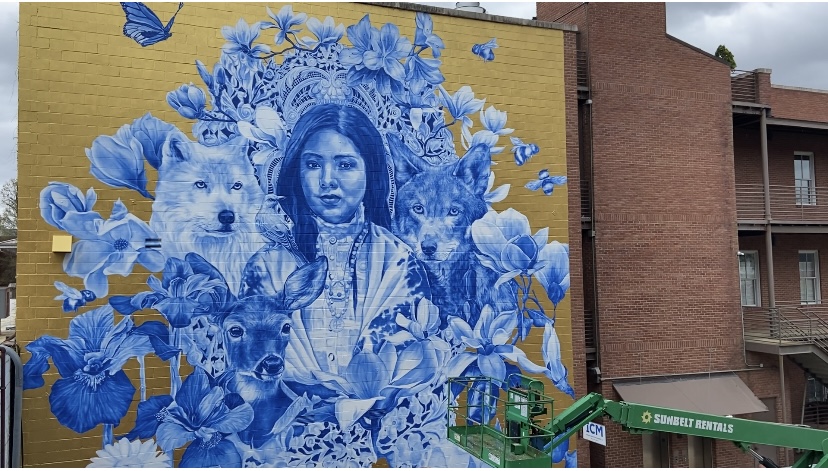A new mural located near the parking garage on the Square depicts “Princess Hoka,” a Chickasaw woman who owned the land that Oxford resides on.

Published on Dec. 11, 2021, an article titled “The myth of the lost Princess Hoka” investigated the true origins of Princess Hoka. Although the article proved that Princess Hoka never existed and that the term “princess” was never used and continues to not be used in Indigenous culture, more information has been reported in regards to Hoka.
Brad R. Lieb, the director of Chickasaw Archaeology for the Chickasaw nation, was one of the major sources for the story and gave much of the information regarding Hoka.
“‘Princess Hoka’ is known only from the land patent record for section 21 which contains most of downtown Oxford. Further records would have to be checked to determine if she actually lived here or somewhere else in Mississippi. She was evidently a single person because she only received one section of land after the removal treaties,” he wrote in the article.
The name “Hoka” does not have a translatable meaning by itself for us today.
“‘Ho’ is a focus marker and ‘ka’ is an old nominalizer (turns something into a noun),” Lieb said. “Many Chickasaws’ names, especially women, were nicknames they earned. There were other Chickasaws around Oxford whose names are preserved in the land patent records from the 1830s: Iahoka, Shahhoka, Cunhoha, Eannayea, Nooscoonah, and Pullumatubby, whose land most of the university is on.”
Since the completion of the mural, questions continued to arise about the validity of the Hoka mural.
The Chickasaw Nation was contacted before the creation of the mural and worked with the artist Anna Murphy.
The face of the Hoka in the mural is a composite of a number of living Chickasaw young women, according to Lieb.
However, the hairstyle Hoka has in the mural is not the typical way women styled their hair in that time.
“The ‘hair down’ look was actually not typical, as most women wore their hair in a bun on the back of the head most of the time. They would wear their hair down and not comb it when they were in mourning for a deceased loved one,” Lieb said. “We approved the hair down look that the artist wanted on the basis that ‘she might be in mourning for something.’”
As for the new information found, Hoka, whose name continues to not mean anything to the knowledge of the Chickasaws, actually lived in Old Town, which is northwest of Tupelo. She most likely never even saw the land at Oxford.
“This was typical because Chickasaws did not live on a neat one square mile spacing, so not every Chickasaw could get the land section (640 acres) on which they lived,” Lieb said. “The eldest within a section got that one, and they would just assign some good sellable land section to you somewhere else in Northeast Mississippi if an elder lived in the same land section as you.”
The facts prove she was a single woman, hence why she received the plot of land in the first place, but according to the deed there is still no age listed for her.
The patent records do show that she sold the land to three land speculators in 1836, the year before the Trail of Tears. The men were buying land from the Chickasaw Cession. However, this patent is the only documentation of Hoka that is found.
It is projected that Hoka received around $800 for the land, which averages to about $1.25 per acre from the Indian Removal Act signed by former President Andrew Johnson.
Because there is still so little information about Hoka herself, the early settlers of Oxford probably never knew Hoka because she was never there.
Although Hoka never saw the land of Oxford, Oxfordians continue to use and display her story and history around the city.
The usage of the term princess continues to be inaccurate, and Lieb argues it to be a bit sexist and racist, but all in all Lieb said that the mural promotes the memory of Chickasaw heritage in North Mississippi.
From the facial expression to the clothing, Lieb said that the mural was depicted accurately enough.
“The animals are photo-realistic and were clan totems. The artist has a style which somewhat resembles the ‘blue transfer print’ patterns on historical refined earthenware dinner plates and such, so that explains the whole floral blue tone,” Lieb said.















